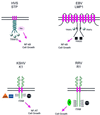Signaling activities of gammaherpesvirus membrane proteins
- PMID: 10644328
- PMCID: PMC111633
- DOI: 10.1128/jvi.74.4.1593-1601.2000
Signaling activities of gammaherpesvirus membrane proteins
Figures



References
-
- Ablashi D V, Levine P H, Papas T, Pearson G R, Kottaridis S D. First international symposium on Epstein-Barr virus and associated malignant diseases. Cancer Res. 1985;45:3981–3984. - PubMed
-
- Albrecht J C, Nicholas J, Cameron K R, Newman C, Fleckenstein B, Honess R W. Herpesvirus saimiri has a gene specifying a homologue of the cellular membrane glycoprotein CD59. Virology. 1992;190:527–530. - PubMed
-
- Alexander, L., L. Denekamp, A. Knapp, M. Auerbach, S. Czajak, B. Damania, and R. C. Desrosiers. The primary sequence of rhesus rhadinovirus isolate 26-95: sequence similarities to Kaposi's sarcoma-associated herpesvirus and rhesus monkey rhadinovirus isolate 17577. J. Virol., in press. - PMC - PubMed
Publication types
MeSH terms
Substances
Grants and funding
LinkOut - more resources
Full Text Sources
Other Literature Sources

